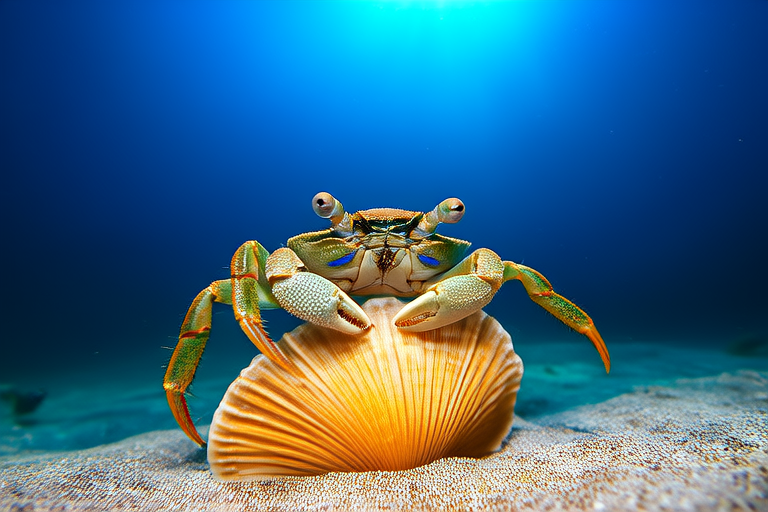Tiny Guardians of the Sea: Unveiling the Life of Pea Crabs
Pea crabs, with their diminutive size and intriguing lifestyle, are often overlooked in the vast oceanic world. These tiny crustaceans, barely larger than a fingernail, live inside the bodies of other marine creatures, forming a unique niche within the aquatic ecosystem. Their fascinating symbiotic relationships with sea cucumbers, clams, and barnacles have captivated scientists and nature enthusiasts alike. This article delves into the world of pea crabs, exploring their physical characteristics, life cycles, and contributions to marine biodiversity.
The Unique Habitat of Pea Crabs
Pea crabs are known for their remarkable ability to coexist within the bodies of other sea creatures. They inhabit various hosts, including sea cucumbers, clams, and barnacles. The relationship between pea crabs and their hosts is mutually beneficial. For instance, sea cucumbers provide a safe haven for pea crabs, while the crabs help clean the sea cucumbers by consuming parasites and detritus. Similarly, pea crabs reside within the mantle cavities of clams, where they feed on plankton and other small organisms, contributing to the clam’s nutrition.
Symbiotic Relationships
The symbiotic relationship between pea crabs and their hosts is a prime example of mutualism in action. In the case of barnacles, pea crabs live inside the calcareous plates of the barnacle, where they are protected from predators and environmental stressors. In return, the crabs consume the barnacle’s waste products, which would otherwise accumulate and harm the host. This intricate partnership ensures the survival of both species, highlighting the complexity and interdependence of marine life.
Physical Characteristics
Pea crabs are characterized by their small size, typically ranging from 3 to 8 millimeters in length. They possess a soft, translucent body covered in fine hairs, which helps them blend seamlessly into their host environments. Their legs are adapted for crawling within tight spaces, and their claws are relatively weak compared to those of larger crab species. Despite their small size, pea crabs are highly agile and can navigate through the complex structures of their hosts with ease.
Life Cycle
The life cycle of pea crabs is a fascinating journey from egg to adult. Females carry their eggs in brood pouches attached to their abdomens until they hatch. The larvae then drift through the water column as part of the zooplankton community before settling on a suitable host. Once attached, the larvae undergo metamorphosis, transforming into juvenile crabs that will eventually reach adulthood. The entire process is a delicate balance of timing and environmental conditions, ensuring the survival of each generation.
Behavior and Challenges
Pea crabs exhibit a range of behaviors that contribute to their survival in the wild. They are known for their nocturnal feeding habits, emerging from their hosts at night to hunt for food. During the day, they remain hidden within their hosts, conserving energy and avoiding potential threats. However, pea crabs face numerous challenges in their natural habitats, including predation by larger marine animals and competition for limited resources. Additionally, human activities such as overfishing and habitat destruction pose significant threats to their populations.
Recent Scientific Discoveries
In recent years, scientists have made several groundbreaking discoveries about pea crabs, shedding light on their biology and ecology. One notable finding is the identification of new species of pea crabs in previously unexplored regions of the ocean. Another discovery is the role of pea crabs in disease control within their host communities. By consuming harmful bacteria and parasites, pea crabs play a crucial role in maintaining the health of their hosts and the broader marine ecosystem.
The Importance of Preservation
The preservation of pea crab habitats is essential for maintaining biodiversity in our oceans. These tiny guardians of the sea play a vital role in the health and stability of marine ecosystems. By protecting their hosts and contributing to nutrient cycling, pea crabs help ensure the survival of countless other species. Therefore, it is imperative to support conservation efforts aimed at safeguarding the delicate balance of marine life.
In conclusion, pea crabs are more than just tiny inhabitants of the ocean; they are integral components of marine ecosystems. Their unique symbiotic relationships, physical adaptations, and contributions to biodiversity make them fascinating subjects of study. As we continue to explore the mysteries of the deep, it is crucial to recognize the importance of preserving these miniature marvels and the habitats that sustain them. By doing so, we can ensure the continued prosperity of our oceans and the myriad life forms they support.
